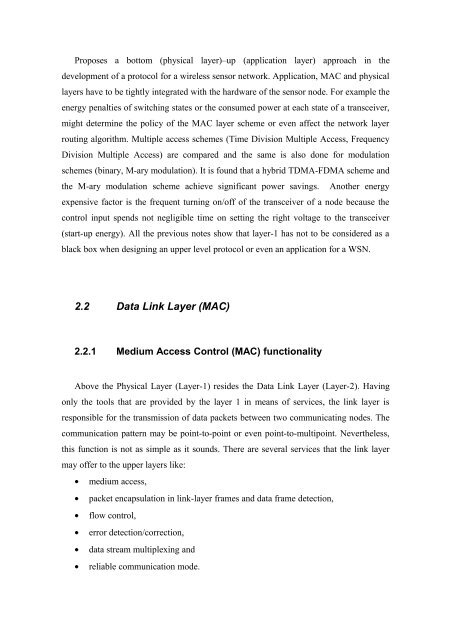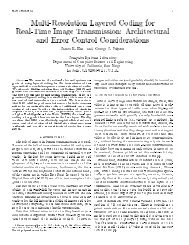In Network Processing and Data Aggregation in
In Network Processing and Data Aggregation in
In Network Processing and Data Aggregation in
Create successful ePaper yourself
Turn your PDF publications into a flip-book with our unique Google optimized e-Paper software.
Proposes a bottom (physical layer)–up (application layer) approach <strong>in</strong> thedevelopment of a protocol for a wireless sensor network. Application, MAC <strong>and</strong> physicallayers have to be tightly <strong>in</strong>tegrated with the hardware of the sensor node. For example theenergy penalties of switch<strong>in</strong>g states or the consumed power at each state of a transceiver,might determ<strong>in</strong>e the policy of the MAC layer scheme or even affect the network layerrout<strong>in</strong>g algorithm. Multiple access schemes (Time Division Multiple Access, FrequencyDivision Multiple Access) are compared <strong>and</strong> the same is also done for modulationschemes (b<strong>in</strong>ary, M-ary modulation). It is found that a hybrid TDMA-FDMA scheme <strong>and</strong>the M-ary modulation scheme achieve significant power sav<strong>in</strong>gs. Another energyexpensive factor is the frequent turn<strong>in</strong>g on/off of the transceiver of a node because thecontrol <strong>in</strong>put spends not negligible time on sett<strong>in</strong>g the right voltage to the transceiver(start-up energy). All the previous notes show that layer-1 has not to be considered as ablack box when design<strong>in</strong>g an upper level protocol or even an application for a WSN.2.2 <strong>Data</strong> L<strong>in</strong>k Layer (MAC)2.2.1 Medium Access Control (MAC) functionalityAbove the Physical Layer (Layer-1) resides the <strong>Data</strong> L<strong>in</strong>k Layer (Layer-2). Hav<strong>in</strong>gonly the tools that are provided by the layer 1 <strong>in</strong> means of services, the l<strong>in</strong>k layer isresponsible for the transmission of data packets between two communicat<strong>in</strong>g nodes. Thecommunication pattern may be po<strong>in</strong>t-to-po<strong>in</strong>t or even po<strong>in</strong>t-to-multipo<strong>in</strong>t. Nevertheless,this function is not as simple as it sounds. There are several services that the l<strong>in</strong>k layermay offer to the upper layers like:• medium access,• packet encapsulation <strong>in</strong> l<strong>in</strong>k-layer frames <strong>and</strong> data frame detection,• flow control,• error detection/correction,• data stream multiplex<strong>in</strong>g <strong>and</strong>• reliable communication mode.








